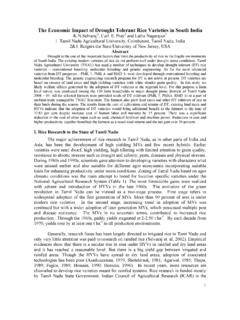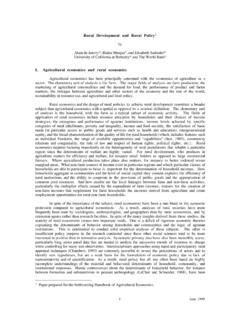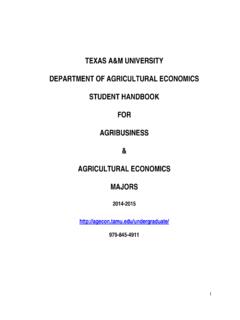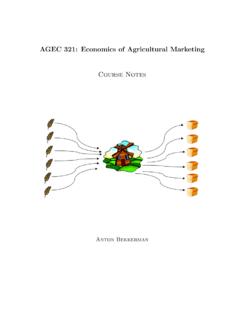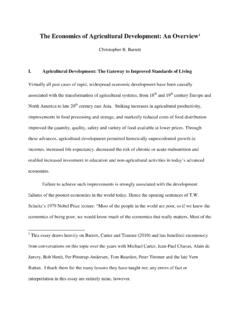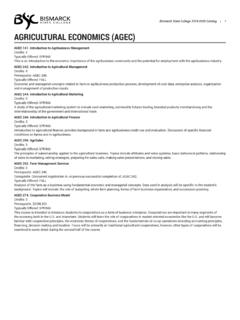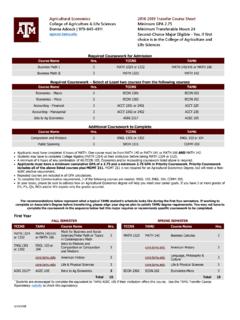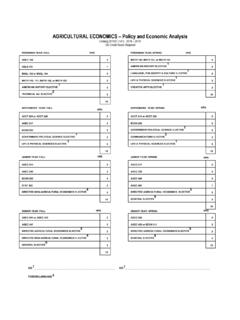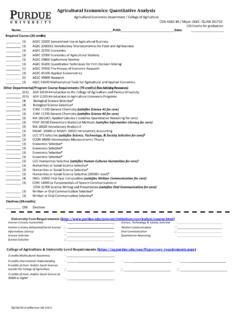Transcription of AGRICULTURAL ECONOMICS: A BRIEF INTELLECTUAL HISTORY
1 Working Paper WP06-1 June 2006 Center for International Food and AGRICULTURAL PolicyResearch, Food and Nutrition, Commodity and Trade,Development Assistance, Natural Resource and Environmental PolicyAGRICULTURAL ECONOMICS: A BRIEF INTELLECTUAL HISTORYbyC. Ford RungeCenter for International Food and AGRICULTURAL PolicyUniversity of MinnesotaDepartment of Applied Economics1994 Buford AvenueSt. Paul, MN Paper WP06-1 June 2006 AGRICULTURAL ECONOMICS: A BRIEF INTELLECTUAL HISTORY by C. Ford Runge* * C.
2 Ford Runge is Distinguished McKnight University Professor of Applied Economics and Law, and Director of the Center for International Food and AGRICULTURAL Policy at the University of Minnesota. This article was prepared at the request of Steven Durlauf in the Department of Economics at the University of Wisconsin for inclusion in a revised edition of The New Palgrave Dictionary of Economics. Thanks for comments and suggestions to Dan Bromley, Willard Cochrane, Jay Coggins, Brian Fisher, Glenn Fox, Sharon Kill, Rob King, Louise Letnes, Dick Levins, Phil Pardey, Steve Polasky, Philip Raup, Vernon Ruttan, G.
3 Edward Schuh, Ben Senauer and Brian Wright. All errors remain the responsibility of the author. CIFAP Working Papers are published without formal review within the Department of Applied Economics. The University of Minnesota is committed to the policy that all persons shall have equal access to its programs, facilities, and employment without regard to race, color, creed, religion, national origin, sex, age, marital status, disability, public assistance status, veteran status, or sexual orientation. Information on other titles in this series may be obtained from Waite Library, University of Minnesota, Department of Applied Economics, 1994 Buford Avenue, 232 ClaOff, St.
4 Paul, MN 55108-6040, The Waite Library e-mail address is: This paper is available electronically from AgEcon Search at AGRICULTURAL Economics: A BRIEF INTELLECTUAL HISTORY Abstract: AGRICULTURAL economics arose in the late 19th century, combined the theory of the firm with marketing and organization theory, and developed throughout the 20th century largely as an empirical branch of general economics. The discipline was closely linked to empirical applications of mathematical statistics and made early and significant contributions to econometric methods.
5 In the 1960 s and afterward, as AGRICULTURAL sectors in the OECD countries contracted, AGRICULTURAL economists were drawn to the development problems of poor countries, to the trade and macroeconomic policy implications of agriculture in richer countries, and to a variety of issues in production, consumption, environmental and resource economics. 2 AGRICULTURAL economics arose in the late 19th century, combined the theory of the firm with marketing and organization theory, and developed throughout the 20th century largely as an empirical branch of general economics.
6 This emphasis was due to the historical importance of agriculture, and in the United States was made possible by the rich data compiled by the Department of Agriculture (USDA) beginning in the mid-19th century. The discipline was closely linked to empirical applications of mathematical statistics and made early and significant contributions to econometric methods. In the 1960 s and afterward, as AGRICULTURAL sectors in the OECD countries contracted, AGRICULTURAL economists were drawn to the development problems of poor countries, to the trade and macroeconomic policy implications of agriculture in richer countries, and to a variety of issues in production, consumption, environmental and resource economics.
7 This ramified the subject and enlarged its international focus, at the same time that its microeconomic, empirical and policy orientation distanced it from developments in general equilibrium theory, macroeconomic modeling, game theory and axiomatic social choice, which preoccupied many departments of economics throughout the late 20th century. Retracing the evolution of AGRICULTURAL economics, especially in the United States, requires an explanation of institutional innovation in 19th century America (see Taylor and Taylor, 1952).
8 In the midst of the Civil War, President Lincoln created the Federal Department of Agriculture (later the Department of Agriculture USDA), empowered to collect a wide range of farm statistics. At the same time, legislation introduced by Vermont s Justin Morrill (previously blocked by the seceded South) was signed in 1862 by Lincoln. The Morrill Act established the Land Grant Colleges 3 (financed through sales of government land) especially in the states of the Old Northwest Territory: Illinois, Indiana, Michigan, Ohio and Wisconsin.
9 Their creation reflected both vast surpluses of land, and the drive to improve plant and animal husbandry through applications of chemistry and biology. Eventually, the land grant model was replicated in every state as well as in some other countries. In 1887, the Hatch Act created the AGRICULTURAL Experiment Stations of USDA, which functioned together with the Land Grant Colleges to form a system of research, instruction and outreach to farmers (Cochrane, 1993; Kerr, 1987; Moore, 1988). In 1914, Extension education and outreach was formalized under the Smith-Lever Act.
10 By the beginning of the 20th century, the application of scientific management to AGRICULTURAL production created the foundations of the discipline. AGRICULTURAL economics in the United States derived from two INTELLECTUAL streams. The first was neoclassical political economy and the theory of the firm applied to farm production. The second, borne of an economic crisis in American agriculture in the late 19th century, focused on strategies for organized marketing of AGRICULTURAL commodities through collective bargaining and cooperatives.


